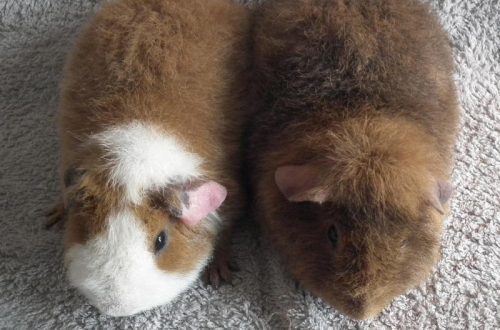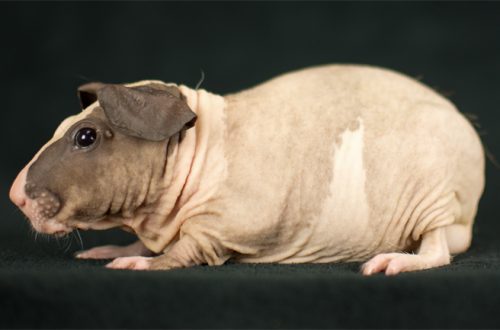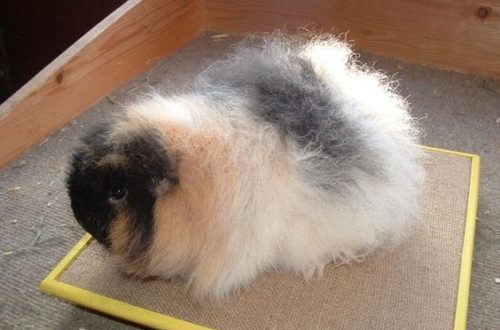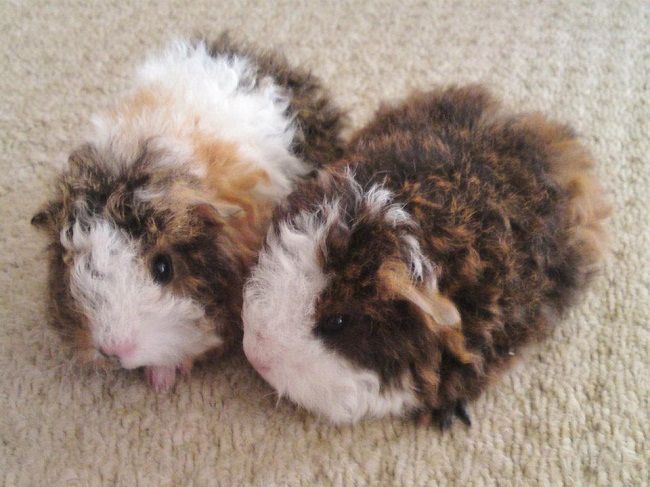
Guinea pig Texel
Texel Guinea Pig (Texel Guinea Pig) is one of the most beautiful breeds of guinea pigs. This is a new and happy rare breed that simply attracts the eye with its chic fur coat. Among the representatives of the long-haired breeds of guinea pigs, perhaps there are no animals with a more flirtatious and funny appearance. Wonderful curls framing a pretty “face” with large expressive eyes, a silky mantle from a cascade of flowing hair on both sides of the parting on the back. Most of all, these pigs are reminiscent of fairy-tale characters who stepped towards us from the pages of Charles Perot and the Brothers Grimm. The sounds of a harpsichord, ostrich feathers and crystal slippers are just asking for additions to the luxurious court toilets of these pigs.
Texel Guinea Pig (Texel Guinea Pig) is one of the most beautiful breeds of guinea pigs. This is a new and happy rare breed that simply attracts the eye with its chic fur coat. Among the representatives of the long-haired breeds of guinea pigs, perhaps there are no animals with a more flirtatious and funny appearance. Wonderful curls framing a pretty “face” with large expressive eyes, a silky mantle from a cascade of flowing hair on both sides of the parting on the back. Most of all, these pigs are reminiscent of fairy-tale characters who stepped towards us from the pages of Charles Perot and the Brothers Grimm. The sounds of a harpsichord, ostrich feathers and crystal slippers are just asking for additions to the luxurious court toilets of these pigs.

Contents
From the history of texels
The Texel breed was artificially bred by crossing Sheltie and Rex guinea pigs. The first texel was born in England around 1980. As a result of selection work and numerous crosses, those texels appeared that we see today. By the end of the 90s of the last century, these adorable pigs appeared as beloved pets in many families, began to participate in shows at shows so often that it became impossible to ignore this new breed any longer. In the USA, the reputable association ACBA included these pigs in its list of officially recognized breeds in 1998. Today Texel is an officially recognized breed in many countries of the world.
The Texel breed was artificially bred by crossing Sheltie and Rex guinea pigs. The first texel was born in England around 1980. As a result of selection work and numerous crosses, those texels appeared that we see today. By the end of the 90s of the last century, these adorable pigs appeared as beloved pets in many families, began to participate in shows at shows so often that it became impossible to ignore this new breed any longer. In the USA, the reputable association ACBA included these pigs in its list of officially recognized breeds in 1998. Today Texel is an officially recognized breed in many countries of the world.
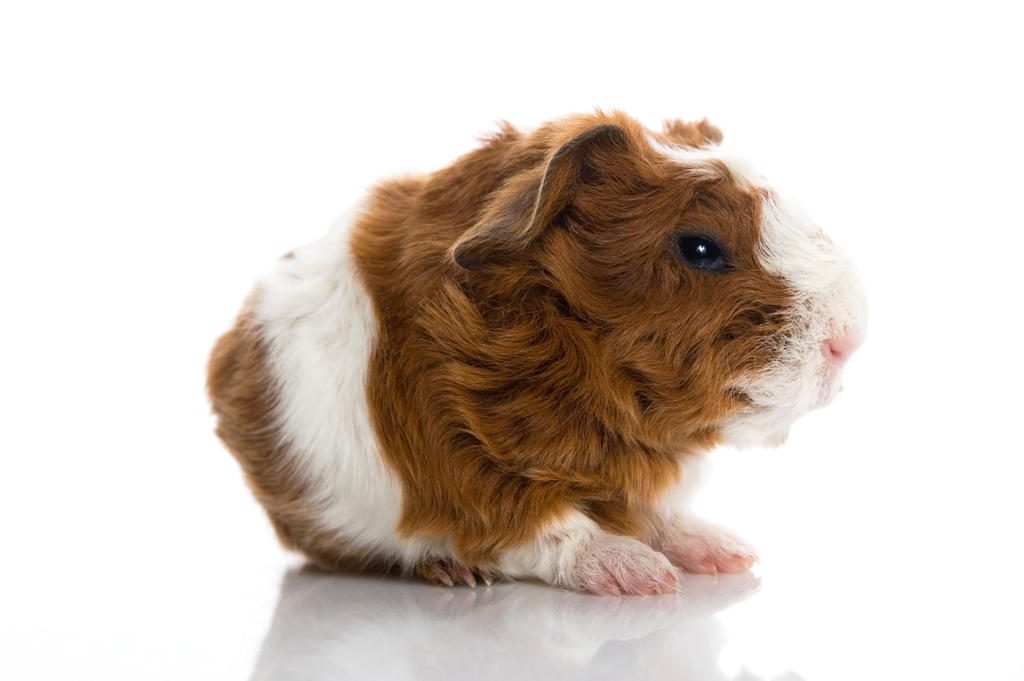
Main features of texels
Texel guinea pigs have long, curly hair that grows from the head towards the rump. Sometimes there may be a parting along the back. Texels are very similar to Shelties, with the only difference being that their hair is twisted into tight curls, like a Rex. The hair on the muzzle is shorter and softer, sometimes with long curls under the ears and lower jaw. Texels typically have a short, muscular, well-shaped body with a broad, round head. Texels are long-haired guinea pigs, so they will be more difficult to care for than short-haired guinea pigs. For this reason, it is often not recommended to buy texels for children and novice breeders.
It is difficult to find this breed in a pet store. Usually these guinea pigs are bought in nurseries. A variation of texel is satin texel, the wool of which is slightly denser and more shiny. But satin texels have not yet received official recognition.
Texel guinea pigs have long, curly hair that grows from the head towards the rump. Sometimes there may be a parting along the back. Texels are very similar to Shelties, with the only difference being that their hair is twisted into tight curls, like a Rex. The hair on the muzzle is shorter and softer, sometimes with long curls under the ears and lower jaw. Texels typically have a short, muscular, well-shaped body with a broad, round head. Texels are long-haired guinea pigs, so they will be more difficult to care for than short-haired guinea pigs. For this reason, it is often not recommended to buy texels for children and novice breeders.
It is difficult to find this breed in a pet store. Usually these guinea pigs are bought in nurseries. A variation of texel is satin texel, the wool of which is slightly denser and more shiny. But satin texels have not yet received official recognition.
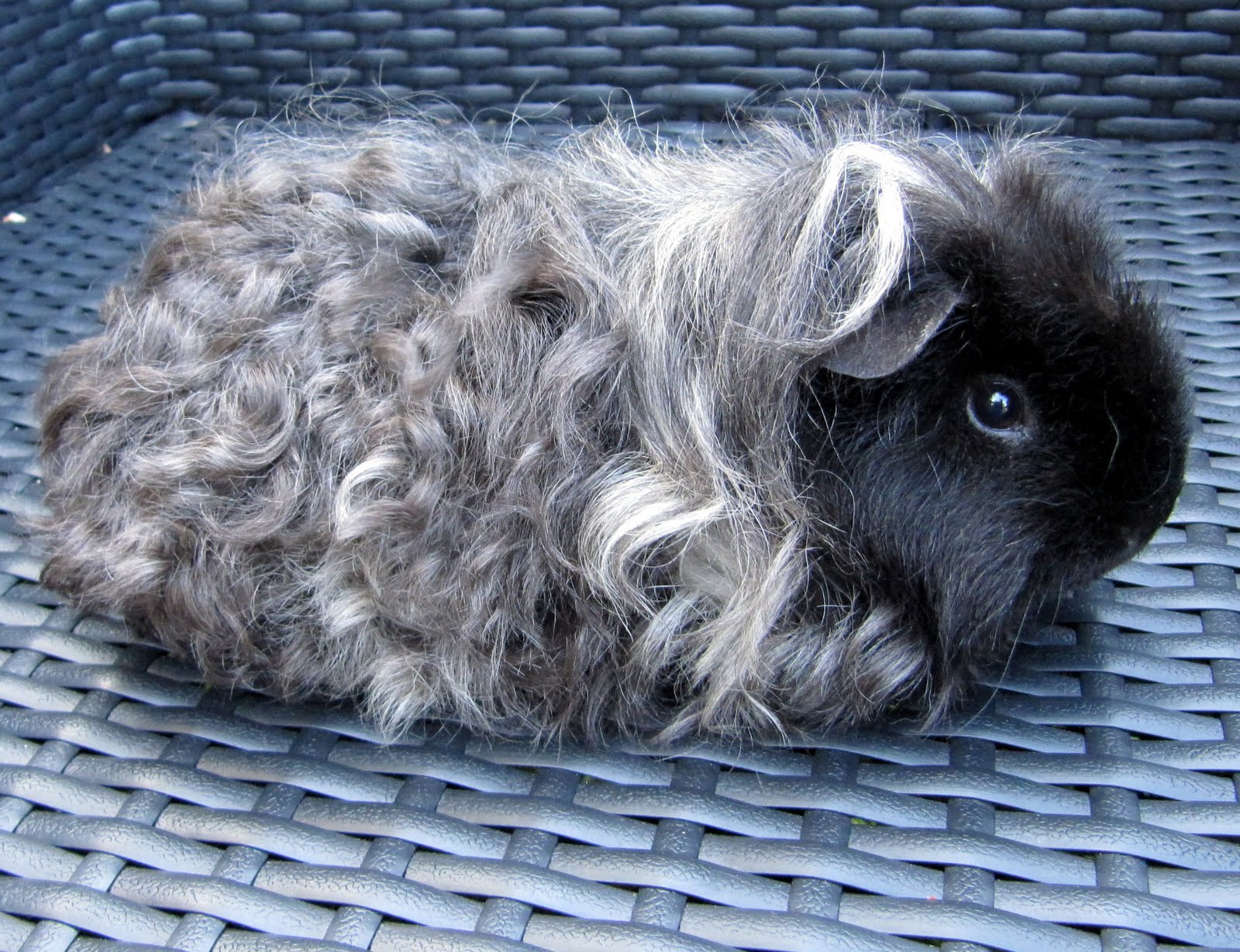
Maintenance and care
For all their pompous appearance, texels are the least demanding of the long-haired breeds. Of course, a texel will require more attention than, say, a simple American guinea pig, but in reality there is nothing frighteningly complex and impossible in the content of texels. The structure of their coat, twisted into tight curls, allows you to “pick up” an elongated cloak and prevents tangling and pollution. Texel coat care Charming newborn texels will immediately show you their “astrakhan” fur coat and it’s up to you to determine how this curly miracle will be cared for. You can, for example, reduce care to a minimum, limited to inspection and elementary cleanliness. And you can comb it regularly and diligently, because, having started intensive care of the texel coat, you will soon see that its thin, silky coat is not all collected again in curls and cannot resist tangles and pollution. Therefore, if the creative impulses of a hairdresser are not alien to you, and the use of hairpins and all sorts of subtleties will give you many pleasant minutes, do not hesitate! Texel is a worthy object for your creativity. True, at the expense of the care and examination of animals, there are two opposing opinions. To comb or not to comb – that is the question! German pig breeders, who have fallen in love with texels and have achieved some success in their breeding, consider the presence of a good curl throughout the body of the pig to be a prerequisite for conformation assessment of the animal. The same opinion is shared by experts from Hungary and Austria. Experts from England, Sweden, Finland and other countries adhering to the English standard require a fully combed texel to be presented to the ring. True, while noting the presence of waviness of the upper cover, as well as curly hair on the abdomen. And yet, whether it is curly-haired lambs coquettishly shaking curls or combed ones that look like huge downy balls or multi-colored giant dandelions, from which cute big-eyed faces look funny, in any case, texel is one of the most spectacular sights at guinea pig shows. I think many will agree with the opinion that texel is the most worthy decoration of the world of guinea pigs. So, no matter what way you choose to care for your pet’s coat, whether you comb it or not, regularly check the guinea pig’s coat for foreign matter (hay, garbage, pieces of food, etc.). Experienced texel breeders urge you to pay special attention on the hair around the anus of a guinea pig. Long hair in this area perfectly absorbs urine, which can adversely affect the appearance of the fur coat. If you and your guinea pig are not going to show, it makes sense to trim your pet’s coat to a comfortable length to keep grooming efforts to a minimum. You can use safety scissors or barber’s scissors to trim your guinea pig. But the most effective (and most convenient!) way will be electric scissors. Do texels need to be bathed? Most guinea pigs do not need regular baths, but long-haired breeds often do, especially if the coat is long. Coming into daily contact with feces, urine, litter or sawdust, a long texel coat will require washing once a month. For information on how to properly organize a bath for your pet, read the article “How to bathe guinea pigs” (LINK to ARTICLE). Other care The most important aspect of caring for any guinea pig is a large and spacious cage and a proper diet. The presence of these two components in the life of a guinea pig is already the key to its long and healthy life. Well, your care and love will make her life even happy. For information on how to choose the right cage for a guinea pig, read the article “Cage for a guinea pig” (LINK to ARTICLE) Texels are very active guinea pigs, especially at a young age, they need a lot of exercise and love to play. They must be regularly released to run on the grass in the summer and around the room in the cold season. But be sure to watch! Guinea pigs are social creatures, in nature they live in large families, and loneliness is fatal for them. In some European countries, keeping a guinea pig alone is prohibited.
For all their pompous appearance, texels are the least demanding of the long-haired breeds. Of course, a texel will require more attention than, say, a simple American guinea pig, but in reality there is nothing frighteningly complex and impossible in the content of texels. The structure of their coat, twisted into tight curls, allows you to “pick up” an elongated cloak and prevents tangling and pollution. Texel coat care Charming newborn texels will immediately show you their “astrakhan” fur coat and it’s up to you to determine how this curly miracle will be cared for. You can, for example, reduce care to a minimum, limited to inspection and elementary cleanliness. And you can comb it regularly and diligently, because, having started intensive care of the texel coat, you will soon see that its thin, silky coat is not all collected again in curls and cannot resist tangles and pollution. Therefore, if the creative impulses of a hairdresser are not alien to you, and the use of hairpins and all sorts of subtleties will give you many pleasant minutes, do not hesitate! Texel is a worthy object for your creativity. True, at the expense of the care and examination of animals, there are two opposing opinions. To comb or not to comb – that is the question! German pig breeders, who have fallen in love with texels and have achieved some success in their breeding, consider the presence of a good curl throughout the body of the pig to be a prerequisite for conformation assessment of the animal. The same opinion is shared by experts from Hungary and Austria. Experts from England, Sweden, Finland and other countries adhering to the English standard require a fully combed texel to be presented to the ring. True, while noting the presence of waviness of the upper cover, as well as curly hair on the abdomen. And yet, whether it is curly-haired lambs coquettishly shaking curls or combed ones that look like huge downy balls or multi-colored giant dandelions, from which cute big-eyed faces look funny, in any case, texel is one of the most spectacular sights at guinea pig shows. I think many will agree with the opinion that texel is the most worthy decoration of the world of guinea pigs. So, no matter what way you choose to care for your pet’s coat, whether you comb it or not, regularly check the guinea pig’s coat for foreign matter (hay, garbage, pieces of food, etc.). Experienced texel breeders urge you to pay special attention on the hair around the anus of a guinea pig. Long hair in this area perfectly absorbs urine, which can adversely affect the appearance of the fur coat. If you and your guinea pig are not going to show, it makes sense to trim your pet’s coat to a comfortable length to keep grooming efforts to a minimum. You can use safety scissors or barber’s scissors to trim your guinea pig. But the most effective (and most convenient!) way will be electric scissors. Do texels need to be bathed? Most guinea pigs do not need regular baths, but long-haired breeds often do, especially if the coat is long. Coming into daily contact with feces, urine, litter or sawdust, a long texel coat will require washing once a month. For information on how to properly organize a bath for your pet, read the article “How to bathe guinea pigs” (LINK to ARTICLE). Other care The most important aspect of caring for any guinea pig is a large and spacious cage and a proper diet. The presence of these two components in the life of a guinea pig is already the key to its long and healthy life. Well, your care and love will make her life even happy. For information on how to choose the right cage for a guinea pig, read the article “Cage for a guinea pig” (LINK to ARTICLE) Texels are very active guinea pigs, especially at a young age, they need a lot of exercise and love to play. They must be regularly released to run on the grass in the summer and around the room in the cold season. But be sure to watch! Guinea pigs are social creatures, in nature they live in large families, and loneliness is fatal for them. In some European countries, keeping a guinea pig alone is prohibited.

The nature of the texels
Texels are usually very friendly, funny and inquisitive guinea pigs, but at the same time they are quite calm and balanced. The combination of these features makes them both excellent pigs for participation in exhibitions, and for keeping as pets. Texels are very fond of people, they easily get used to a new owner, they love to be stroked and picked up. They get along great with children.
Texels are usually very friendly, funny and inquisitive guinea pigs, but at the same time they are quite calm and balanced. The combination of these features makes them both excellent pigs for participation in exhibitions, and for keeping as pets. Texels are very fond of people, they easily get used to a new owner, they love to be stroked and picked up. They get along great with children.
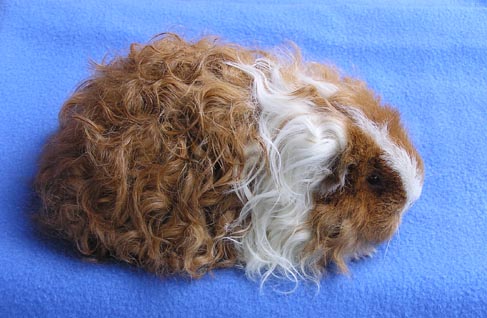
Texel colors
Texels can be of any color, both single-color and multi-color, with any combination of colors in color. Any color is acceptable for participation in exhibitions.
Texels can be of any color, both single-color and multi-color, with any combination of colors in color. Any color is acceptable for participation in exhibitions.

So, Texel is a truly gorgeous guinea pig with an amazing fur coat. As a pet, the Texel is the easiest of all long-haired gilts to care for, but nevertheless these animals are made for the most dedicated owners. If you are willing to spend some time on the extra care of their luxurious coat, then this breed is perfect for you.
So, Texel is a truly gorgeous guinea pig with an amazing fur coat. As a pet, the Texel is the easiest of all long-haired gilts to care for, but nevertheless these animals are made for the most dedicated owners. If you are willing to spend some time on the extra care of their luxurious coat, then this breed is perfect for you.



